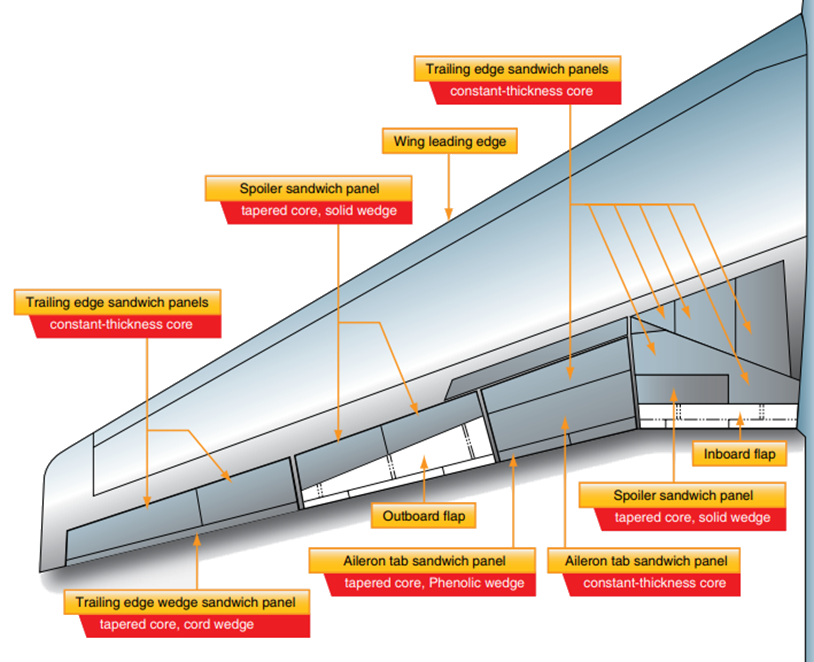
![]() Home > News
Home > News
Source:https://www.aircraft-aluminium.com/a/7055-7150-2024-aluminum-plate-for-aircraft-wing-panel.html
Aircraft aluminum sheet is a key material for aircraft wing panels due to its excellent strength, lightweight, and corrosion resistance. In aircraft wing panel design, 7055, 7150 and 2024 aluminum plate are widely used due to their unique performance characteristics. The specific selection requires consideration of multiple factors, including structural strength, fatigue performance, processing technology and cost.

Alloy Characteristics and Application Scenarios
1. 7055 Aluminum Alloy
- Performance Advantages:
As a fourth-generation ultra-high-strength aluminum alloy (Al-Zn-Mg-Cu system), 7055-T7751 aluminum boasts a tensile strength exceeding 600 MPa and excellent fracture toughness. Shot peening increases its fatigue limit by 41.2% (from 131 MPa to 185 MPa). Its through-hardening depth of approximately 45 mm makes it suitable for the integrated manufacturing of medium-thick sheet materials.
- Application Examples:
The Boeing 777's upper wing skin, wing stringers, and other critical load-bearing structures must withstand high cyclic loads and complex stress distributions. Its high strength and fatigue resistance make it a core material for wing panels on large passenger aircraft.
2. 7150 Aluminum Alloy
- Performance Advantages:
Also an Al-Zn-Mg-Cu alloy, 7150-T7751 aluminum boasts a tensile strength of approximately 540 MPa, a yield strength of 500 MPa, an elongation of 10%, and a through-hardening depth of 63 mm, making it suitable for thicker structural parts. It exhibits fewer quenched precipitations, low lattice distortion energy, and superior machinability compared to 7055.
- Application Examples:
The Airbus A380's upper wing skin and reinforcement panels, as well as the horizontal stabilizer of military aircraft. Its large plate sizes (up to 2500mm wide) reduce weld seams and improve structural integrity.
- Technical Features:
Spray forming technology refines grain size, reduces oxide inclusion content, and further enhances corrosion resistance.
- Performance:
This Al-Cu-Mg alloy (T351 temper) boasts a tensile strength of approximately 470 MPa, a yield strength of 325 MPa, and an elongation of 20%. It offers excellent processability but poor corrosion resistance, requiring aluminum cladding for enhanced protection.
- Applications:
Traditionally used in medium-loaded areas such as wing ribs and webs, such as some secondary structures on the Boeing 737. In modern aircraft, it has been gradually replaced by 2524 aluminum alloy, but it still finds use in cost-sensitive projects.
- Limitations:
Its high fatigue crack growth rate makes it unsuitable for primary load-bearing components subjected to long-term high-frequency vibration.
Key Performance Comparison and Selection Criteria of Aircraft Aluminum For Wing Panels:
Performance Index | 7055-T7751 | 7150-T7751 | 2024-T351 |
Tensile Strength (MPa) | 600+ | 540 | 470 |
Fatigue Limit (MPa) | 185 (after shot peening) | approximately 150 | approximately 120 |
Through Hardening Depth | 45mm | 63mm | Not Required |
Corrosion Resistance | Excellent (Coating Required) | Excellent (Coating Required) | Poor (Aluminum Cladding Required) |
Processing Cost | High (Complex Process) | Medium (Relatively Easy to Process) | Low (Mature Process) |
Typical Applications | Wing Skins and Stringers (Boeing 777) | Upper Wing Skins (Airbus A380) | Ribs and Webs (Traditional Aircraft) |
Selection Logic:
- For high-load primary structures: 7055 or 7150 is preferred. Both offer superior strength and fatigue properties to 2024. 7055 Suitable for medium-thickness plates, 7150 is more suitable for large, thick plates.
- For secondary structures and cost-sensitive projects: 2024 remains cost-effective, but the cost of anti-corrosion treatment must be weighed against this.
- Process suitability: 7055 and 7150 require high-precision processing equipment, while 2024 can be processed through conventional rolling and cutting.
In summary, the application of these aircraft aluminum alloys in wing panels reflects the comprehensive trade-off between "strength, toughness, and cost" in aviation materials. With their excellent comprehensive performance, 7055 and 7150 have become core materials for the design of modern large passenger aircraft wings.